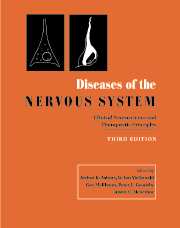Book contents
- Frontmatter
- Dedication
- Contents
- List of contributors
- Editor's preface
- PART I INTRODUCTION AND GENERAL PRINCIPLES
- 1 Pathophysiology of nervous system diseases
- 2 Genetics of common neurological disorders
- 3 Repeat expansion and neurological disease
- 4 Cell birth and cell death in the central nervous system
- 5 Neuroprotection in cerebral ischemia
- 6 Promoting recovery of neurological function
- 7 Measurement of neurological outcomes
- 8 Principles of clinical neuro-epidemiology
- 9 Principles of therapeutics
- 10 Windows on the working brain: functional imaging
- 11 Windows on the working brain: magnetic resonance spectroscopy
- 12 Windows on the working brain: evoked potentials, magnetencephalography and depth recording
- PART II DISORDERS OF HIGHER FUNCTION
- PART III DISORDERS OF MOTOR CONTROL
- PART IV DISORDERS OF THE SPECIAL SENSES
- PART V DISORDERS OF SPINE AND SPINAL CORD
- PART VI DISORDERS OF BODY FUNCTION
- PART VII HEADACHE AND PAIN
- PART VIII NEUROMUSCULAR DISORDERS
- PART IX EPILEPSY
- PART X CEREBROVASCULAR DISORDERS
- PART XI NEOPLASTIC DISORDERS
- PART XII AUTOIMMUNE DISORDERS
- PART XIII DISORDERS OF MYELIN
- PART XIV INFECTIONS
- PART XV TRAUMA AND TOXIC DISORDERS
- PART XVI DEGENERATIVE DISORDERS
- PART XVII NEUROLOGICAL MANIFESTATIONS OF SYSTEMIC CONDITIONS
- Complete two-volume index
- Plate Section
6 - Promoting recovery of neurological function
from PART I - INTRODUCTION AND GENERAL PRINCIPLES
Published online by Cambridge University Press: 05 August 2016
- Frontmatter
- Dedication
- Contents
- List of contributors
- Editor's preface
- PART I INTRODUCTION AND GENERAL PRINCIPLES
- 1 Pathophysiology of nervous system diseases
- 2 Genetics of common neurological disorders
- 3 Repeat expansion and neurological disease
- 4 Cell birth and cell death in the central nervous system
- 5 Neuroprotection in cerebral ischemia
- 6 Promoting recovery of neurological function
- 7 Measurement of neurological outcomes
- 8 Principles of clinical neuro-epidemiology
- 9 Principles of therapeutics
- 10 Windows on the working brain: functional imaging
- 11 Windows on the working brain: magnetic resonance spectroscopy
- 12 Windows on the working brain: evoked potentials, magnetencephalography and depth recording
- PART II DISORDERS OF HIGHER FUNCTION
- PART III DISORDERS OF MOTOR CONTROL
- PART IV DISORDERS OF THE SPECIAL SENSES
- PART V DISORDERS OF SPINE AND SPINAL CORD
- PART VI DISORDERS OF BODY FUNCTION
- PART VII HEADACHE AND PAIN
- PART VIII NEUROMUSCULAR DISORDERS
- PART IX EPILEPSY
- PART X CEREBROVASCULAR DISORDERS
- PART XI NEOPLASTIC DISORDERS
- PART XII AUTOIMMUNE DISORDERS
- PART XIII DISORDERS OF MYELIN
- PART XIV INFECTIONS
- PART XV TRAUMA AND TOXIC DISORDERS
- PART XVI DEGENERATIVE DISORDERS
- PART XVII NEUROLOGICAL MANIFESTATIONS OF SYSTEMIC CONDITIONS
- Complete two-volume index
- Plate Section
Summary
This chapter focuses on the biologically driven strategies that are being developed to enhance that recovery following neural injury. It is beyond the scope of this chapter to review the entire field of neurologic rehabilitation, much of which involves orthotic, prosthetic, behavioural, psychological and sociological approaches. Many of these approaches are accumulating substantial evidence for their effectiveness and their omission here should not be interpreted as an indication of lack of importance. Several recent monographs on neurologic rehabilitation cover them in greater detail (Dobkin, 1996; Lazar, 1998; Ozer, 2000). Here, the behavioural, physiological and structural mechanisms by which the nervous system adapts spontaneously to injury will be reviewed. Then some promising current approaches to optimizing recovery by utilizing the nervous system's own adaptive processes will be discussed. Finally the mechanisms that limit the ability of the nervous system to reconstitute the lost neural circuitry will be examined, and strategies that are being developed to overcome these limitations will be summarized.
Mechanisms of spontaneous recovery
Following injury to the nervous system, it is usual for patients to recover to a variable degree. This is a consequence of three processes. First, depending on the type of injury, an ischemic/traumatic penumbra (Heiss & Graf, 1994; Tator, 1995) results in temporary dysfunction of neuronal elements due to pressure from edema, excitotoxicity with intracellular (intramitochondrial) calcium accumulation (Stout et al., 1998), extracellular accumulation of potassium and magnesium, and inflammation (Carlson et al., 1998) (Fig. 6.1). If they do not kill the neurons, these changes eventually resolve and neuronal function is restored. Secondly, patients can employ a variety of behavioural adaptations to restore equivalent functions to those lost as a consequence of the structural and physiological alterations brought about by the injury. Thirdly, physiological changes and short distance anatomic rearrangements in spared neural pathways may result in compensatory enhancement in transmission through those pathways to reproduce or substitute for lost functions. A fourth mechanism, frank regeneration of injured axons and replacement of lost neurons to reconstitute the interrupted synaptic circuits, is currently believed not to occur to a significant degree in the mammalian CNS. Strategies to promote such neural repair are discussed later in the chapter.
- Type
- Chapter
- Information
- Diseases of the Nervous SystemClinical Neuroscience and Therapeutic Principles, pp. 79 - 104Publisher: Cambridge University PressPrint publication year: 2002

